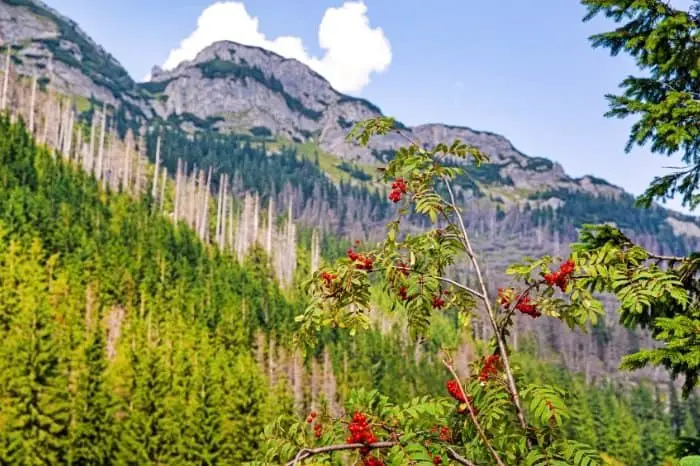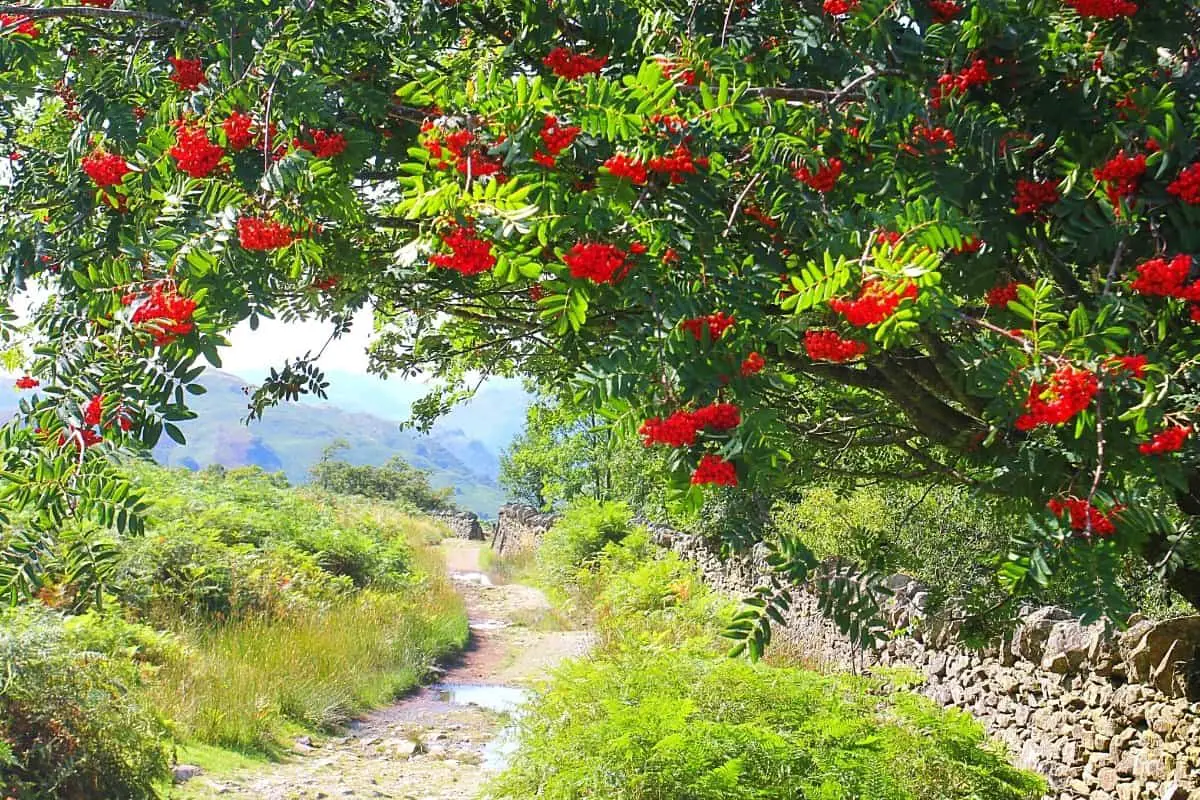Last Updated on January 20, 2022 by
Have you ever wanted to find out where do rowan trees grow so you can grow your own and enjoy their beauty and some shade during summer?
Rowan tree, also known as the mountain ash due to the fact that it thrives at high altitudes is an ornamental tree loved by many.
It is a hardy little mountain ash tree with soft, delicate, and fern-shaped leaves. This tree is commonly grown for its beauty and provides an excellent source of shade during summer because it’s wide.
It blossoms generously in the spring producing creamy white flowers and round reddish-orange berries that follow the flowering. The leaves of this tree turn into a splendid color during autumn that will inspire you even as you rake them.
Where Do Rowan Trees Grow?
Rowan tree (Sorbus aucuparia) is the most widely planted ash tree and it does well in USDA Hardiness zones 3 to 5.
It thrives in the wild all over Northern Europe and also does well when planted in gardens. The berries are food to the wildlife and migrating birds.
Rowan has a rich history and is adored by many who grow it for its protective powers in the mountain and cottage gardens.

It is believed to ward off witches and evil spirits with its mythical virtues. It is also revered as the Tree of Good Luck’ but even without these two mythical believes it still a beauty to grow in your garden.
Rowan is native to cooler regions of the Northern Hemisphere mostly in the UK and also does well in Scotland.
Read more about How Fast Do Windmill Palm Trees Grow?
How Do Rowan Mountain Ash Trees Grow?
Now that we know where rowan trees grow it’s time to grow your own.
The best time to plant your rowan tree is in late fall when the young tree is dormant. Plant it in full sun or partly shaded area.
Dig a hole that is 3 times the width of the root ball, then place the tree in the hole and fill it with soil around it.
Use well-drained soils although this tree adapts to any conditions including rocky and clay soils too.
Water this tree deeply and stake your tree for support so that it grows straight up. This tree prefers to have its soil moist most times for better growth. However, it tolerates long dry spells, cold and wind, but growing it in your garden giving it good care will make it look more beautiful.
You can prune your rowan tree when young to remove vertical branches or the crossover branches. A mature tree will no longer require pruning.
The rowan tree berries are rich in Vitamin C. They have a bitter flavor that is not a favorite to many people. They can be used to make jellyfish tastier. You can harvest them after they are overripe or after the frost which in most cases they are sweeter. But the birds might not leave them for this long.
Rowan Ash Tree Pests And Diseases
The rowan tree is tough and tenacious and prone to many diseases and pest infestation. If grown in cold regions, it is not prone to many diseases, but it fights the fire blight with ease in warmer areas. This bacterial disease does not have a cure, you can only cut off the infected branches to avoid more infection.
You might notice lichen growing on the bark of this tree but it’s not a harmful problem to the tree or you. Deer love to eat the leaves of the rowan tree. It could be a problem if your area has too many. Soon they will flood your garden attracted by this tree.
Deer Out 32oz Concentrate Deer Repellent
Conclusion About Rowan Plant
Did you know you can harvest your own seeds from the rowan berries? Harvest the ripe berries and store them in a bucket for 2 to 3 weeks. Ensure the seeds are in a cool dry place. In those 3 weeks, the seeds mature until they are ready for extraction.
The extraction is a tough task that needs a tool to extract them. Do not harvest under-ripe fruits because they are tough to extract.
When you break the berry you will notice the seeds stick to the soft inner flesh of the fruit. To make your work easier, you can leave the berries to rot a little bit before removing the seeds. This makes the process easier. This method could damage the seeds if left to rot for too long.
You can also opt to mash them to make the extraction process easier. Use a bucket, a mallet head, a flat bottomed pole, and a kitchen sieve to extract the berries. It’s quite a tedious task but well worth the effort as you will have plenty of seeds to start a new nursery of rowan plants.
FAQs
Where do rowan trees like to grow?
Rowan trees can be found in the north of Scotland, in Ireland and even in England. There are more than one thousand varieties of Rowan trees, but they all share some common characteristics. They have a very thick trunk, which gives them strength and durability. Their bark is rough and dark brown or greyish in colour. The leaves grow in pairs on opposite sides of the tree and each pair is slightly different from the other.
What does a happy Rowan tree look like?
It has a pleasant aromatic smell. When the flowers are ready to bloom, they form into clusters at the tips of the branches. The flowers are a deep blue in colour and have five petals. The fruit grows directly from the stem of the tree and is usually black when it ripens. The fruit is called a berry, and it contains a seed. The Rowan tree can be used for making herbal tea, and the berries can be used for jam.
The fruits of the Rowan tree are very nutritious and contain vitamins C, A, B2, and E. The fruit contains a high level of antioxidants and can protect against cancer and heart disease. It is also known as the Mountain Ash or Mountain Hawthorn, and the Rowan tree can grow up to 30 feet tall.
What does it prefer in order to grow healthily?
It prefers a temperate climate and is found in the Himalayas and the Mediterranean. How to Grow the Rowan Tree It takes approximately seven years for a Rowan tree to grow to full maturity. The seedlings need to be planted in the springtime. The seeds should be planted in a large pot with an open bottom.
The pot should be filled with potting soil. A light sprinkling of soil should be left on top of the soil as it is best to let the soil dry out slightly before planting the seeds. The soil should not be allowed to get too wet as this could kill the young seedlings. The roots of the Rowan tree are shallow and spread out over a wide area.
The rowan is actually a species of hazel. The botanical name is Sorbus aucuparia. The most common way to recognize a rowan is to look for the five-petaled flowers in late spring and early summer. (If you are lucky, you may even see them when they bloom.) The leaves can be easily recognized by their alternate arrangement (not opposite).
What is special about a rowan tree?
Rowans are a small genus of deciduous trees native to the Northern Hemisphere. They have been grown in Europe for centuries, and some were used as medicine by the Romans. Rowan wood was once considered a good material for making bows. The name "rowan" comes from the Middle English word "rowen," which means "to burn." This is because the berries look like glowing coals when they are on fire.
Caroline is a gardener who loves to get down to the nitty–gritty of gardening. She proudly proclaims herself as a ‘dirt worshipper‘ and can often be found deep in the garden, covered in soil and singing to her plants. As a self–proclaimed ‘plant whisperer‘, Caroline believes that plants need love and attention just like any other living thing, and she loves to give them both. When she‘s not tending to her garden, you can often find her researching the latest gardening trends, or teaching others how to make their gardens thrive



